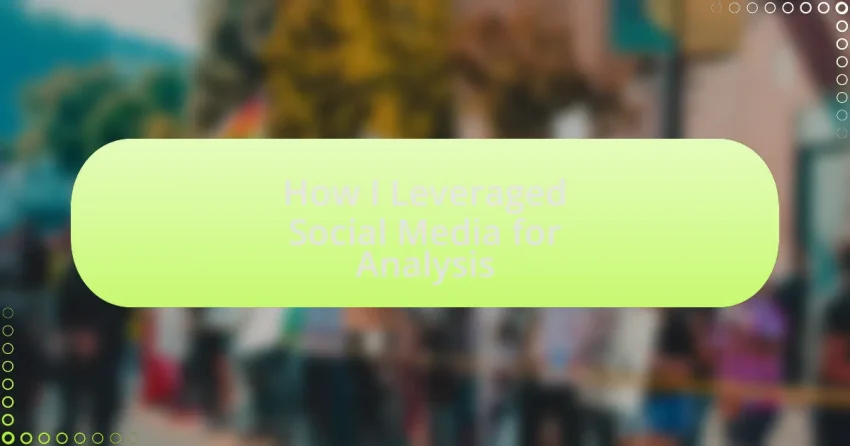Key takeaways:
- Social media dynamics influence public sentiment and political landscapes, with real-time reactions shaping discussions and policy debates.
- Social media analysis helps gauge public opinion and identify emerging trends, revealing insights that traditional channels may overlook.
- Effective political commentary relies on authenticity, active listening, and integrating data with personal stories to resonate with audiences.
- Tools like Brandwatch, Hootsuite Insights, and Google Trends enhance social media analysis, simplifying complex data for better understanding of public discourse.
Author: Evelyn Hartwood
Bio: Evelyn Hartwood is an acclaimed author known for her enchanting tales that blend magical realism with poignant human experiences. With a degree in Literature from the University of California, Berkeley, she has captivated readers worldwide with her lyrical prose and richly developed characters. Evelyn has published three best-selling novels, including “Whispers of the Willow” and “The Echoing Silence,” both praised for their emotional depth and imaginative storytelling. When she’s not writing, Evelyn enjoys exploring the outdoors, indulging her passion for nature photography, and hosting workshops that inspire aspiring writers. She currently resides in a quaint cabin in the Pacific Northwest, where she finds endless inspiration among the towering trees and serene landscapes.
Understanding social media dynamics
Social media dynamics are deeply intertwined with human emotion and interaction. I remember the first time I observed a heated political debate unfold in real-time on Twitter. It struck me how quickly opinions could shift, influenced by a single viral post. Isn’t it fascinating how a tweet can ignite a nationwide conversation within minutes?
Understanding these dynamics requires us to pay attention to the algorithms that govern visibility on these platforms. For instance, I often wonder how much our individual feeds reflect not just our interests, but also a carefully curated echo chamber. It’s a stark realization—one that makes me question the authenticity of the information I consume.
In my experience, the interplay between trending topics and public sentiment shapes the political landscape more than we might realize. For example, when an issue gains momentum online, I’ve seen it translate into real-world action, sometimes even changing the course of policy debates. Isn’t it intriguing how a snapshot of public opinion online can steer the narrative in profound ways?
Importance of social media analysis
Social media analysis is essential because it allows us to gauge public sentiment in real-time. I recall a moment when a particular political figure faced backlash after a controversial statement was posted. Observing the immediate flood of reactions across platforms not only highlighted public outrage but also indicated potential shifts in voter loyalty. How often do we truly understand the power of a simple hashtag in shaping perceptions?
Moreover, analyzing social media data can reveal emerging trends and concerns that may not surface through traditional channels. I once uncovered a growing unease among young voters regarding climate policy, primarily articulated in social media discussions. This insight urged me to explore deeper interactions, allowing me to appreciate how these voices shape the broader political narrative.
The beauty of social media analysis lies in its ability to uncover hidden insights that inform more effective political commentary. I’ve often found that diving into analytics—like engagement rates and sentiment scores—has transformed my approach to discussions and articles. Isn’t it powerful to think that these digital conversations can reflect deeper societal values and concerns?
Tools for social media analysis
One tool I often turn to for social media analysis is Brandwatch. Its ability to sift through vast amounts of data and pinpoint specific conversations is remarkable. I remember using it during an election cycle when I wanted to track how different demographics felt about candidates; the insights were eye-opening. Have you ever felt overwhelmed by the sheer volume of online chatter? Tools like Brandwatch simplify this chaos.
Another favorite of mine is Hootsuite Insights, which offers real-time analytics that help me understand engagement levels. When I was working on a piece about public reaction to education policies, Hootsuite visually mapped sentiment, allowing me to see shifts almost immediately. How incredible is it to watch public opinion evolve in front of your eyes? For those who invest time in understanding these trends, the payoff in enhanced commentary is significant.
Lastly, I can’t overlook the power of Google Trends. It presents a clear look at what people are searching for and discussing, and I often use it to identify emerging issues. I once stumbled upon a surge in searches related to political protests, which directed my writing focus for weeks. Have you thought about how searching behaviors can illuminate the political landscape? It’s these little insights that often pave the way for deeper discussions and connections with the audience.
Strategies for effective political commentary
When it comes to effective political commentary, the key is to stay authentic. I’ve personally found that sharing my genuine reactions to news events resonates more with my audience than simply reciting facts. Have you ever noticed how a heartfelt opinion can spark a dialogue? It’s surprising how vulnerability can create a connection, allowing readers to see me as a relatable voice in a polarized environment.
Another strategy that I often employ is to actively listen to diverse perspectives on social media. I remember a time when I joined a heated debate online about immigration policy. Instead of sticking to my own views, I engaged with differing opinions, which enriched my understanding and ultimately shaped my commentary. How else can we truly grasp complex issues if we don’t immerse ourselves in the discourse?
Lastly, I recommend integrating data into your narrative. By weaving statistics with personal stories, I can illustrate the real-world implications of political decisions. For instance, while discussing healthcare reforms, I cited a statistic about the number of uninsured people but also shared a friend’s experience navigating the system. How do you think combining numbers with human stories affects the way we perceive political issues? This blend creates a fuller picture, making the commentary more impactful and relatable.
